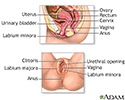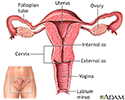Cervicitis
Cervical inflammation; Inflammation - cervixCervicitis is swelling or inflamed tissue of the end of the uterus (cervix).
Cervix
The cervix is the lower end of the womb (uterus). It is at the top of the vagina. It is about 2. 5 to 3. 5 centimeters (1 to 1. 3 inches) long. Th...

Causes
Cervicitis is most often caused by an infection that is caught during sexual activity. Sexually transmitted infections (STIs) that can cause cervicitis include:
-
Chlamydia
Chlamydia
Chlamydia is an infection caused by the bacteria Chlamydia trachomatis. It is most often spread through sexual contact.
 ImageRead Article Now Book Mark Article
ImageRead Article Now Book Mark Article -
Gonorrhea
Gonorrhea
Gonorrhea is a common sexually transmitted infection (STI).
Read Article Now Book Mark Article - Herpes simplex virus (genital herpes)
Genital herpes
Genital herpes is a sexually transmitted infection. It is caused by the herpes simplex virus (HSV). This article focuses on HSV type 2 infection....
Read Article Now Book Mark Article - Human papilloma virus (genital warts)
Genital warts
Genital warts are soft growths on the skin and mucous membranes of the genitals. They may be found on the penis, vulva, urethra, vagina, cervix, and...
Read Article Now Book Mark Article -
Trichomoniasis
Trichomoniasis
Trichomoniasis is a sexually transmitted infection caused by the parasite Trichomonas vaginalis.
 ImageRead Article Now Book Mark Article
ImageRead Article Now Book Mark Article
Other things that can cause cervicitis include:
- A device inserted into the pelvic area such as a cervical cap, diaphragm, IUD, or pessary
- Allergy to spermicides used for birth control
- Allergy to latex in condoms
- Exposure to a chemical
- Reaction to douches or vaginal deodorants
Cervicitis is very common. It affects more than one half of all women at some point during their adult life. Causes include:
- High-risk sexual behavior
- History of STIs
- Many sexual partners
- Sexual intercourse at an early age
- Sexual partners who have engaged in high-risk sexual behavior or have had an STI
Too much growth of some bacteria that normally are present in the vagina (bacterial vaginosis) can also lead to cervical infection.
Bacterial vaginosis
Bacterial vaginosis (BV) is a type of vaginal infection. The vagina normally contains both healthy bacteria and unhealthy bacteria. BV occurs when ...
Read Article Now Book Mark ArticleSymptoms
There may be no symptoms. If symptoms are present, these may include:
-
Abnormal vaginal bleeding that occurs after intercourse, or between periods
Abnormal vaginal bleeding
This article discusses vaginal bleeding that occurs between a woman's monthly menstrual periods. Such bleeding may be called "intermenstrual bleedin...
 ImageRead Article Now Book Mark Article
ImageRead Article Now Book Mark Article - Unusual vaginal discharge that does not go away: discharge may be gray, white or yellow in color
Vaginal discharge
Vaginal discharge refers to secretions from the vagina. The discharge may be:Thick, pasty, or thinClear, cloudy, bloody, white, yellow, or greenOdor...
 ImageRead Article Now Book Mark Article
ImageRead Article Now Book Mark Article - Painful sexual intercourse
- Pain in the vagina
- Pressure or heaviness in the pelvis
- Painful urination
- Vaginal itching
Women who may be at risk for chlamydia should be tested for this infection, even if they do not have symptoms.
Exams and Tests
A pelvic exam is done to look for:
- Discharge from the cervix
- Redness of the cervix
- Swelling (inflammation) of the walls of the vagina
Tests that may be done include:
-
Inspection of the discharge under a microscope (may show candidiasis, trichomoniasis, or bacterial vaginosis)
Inspection
In medical terms, "inspection" means to look at the person or body part. It is the first step in a physical exam.
Read Article Now Book Mark ArticleCandidiasis
Vaginal yeast infection is an infection of the vagina. It is most often due to the fungus Candida albicans.
 ImageRead Article Now Book Mark Article
ImageRead Article Now Book Mark ArticleTrichomoniasis
Trichomoniasis is a sexually transmitted infection caused by the parasite Trichomonas vaginalis.
 ImageRead Article Now Book Mark Article
ImageRead Article Now Book Mark Article -
Pap test
Pap test
The Pap test mainly checks for changes in the cervix that may turn into cervical cancer. Cells scraped from the opening of the cervix are examined u...
 ImageRead Article Now Book Mark Article
ImageRead Article Now Book Mark Article - Tests for gonorrhea and chlamydia
Rarely, colposcopy and biopsy of the cervix is necessary.
Colposcopy and biopsy of the cervix
A colposcopy is a special way of looking at the cervix. The cervix is the lower part of the uterus (womb) that opens at the top of the vagina. Abno...

Treatment
Antibiotics are used to treat chlamydia or gonorrhea. Medicines called antivirals may be used to treat herpes simplex virus infections.
Hormonal therapy (with estrogen or progesterone) may be used in women who have reached menopause.
Outlook (Prognosis)
Most of the time, simple cervicitis usually heals with treatment if the cause is found and there is a treatment for that cause.
Often, cervicitis does not cause any symptoms. It doesn't need treatment as long as tests for bacterial and viral causes are negative.
Possible Complications
Cervicitis may last for months to years. Cervicitis may lead to pain with intercourse.
Untreated cervicitis may lead to inflammation involving the female pelvic organs, causing a condition called pelvic inflammatory disease (PID).
Pelvic inflammatory disease (PID)
Pelvic inflammatory disease (PID) is an infection of a woman's womb (uterus), ovaries, or fallopian tubes.

When to Contact a Medical Professional
Contact your health care provider if you have symptoms of cervicitis.
Prevention
Things you can do to reduce your risk of developing cervicitis include:
- Avoid irritants such as douches and deodorant tampons.
Irritants
Chemicals that touch skin can lead to a reaction on the skin, throughout the body, or both.
 ImageRead Article Now Book Mark Article
ImageRead Article Now Book Mark Article - Make sure that any foreign objects you insert into your vagina (such as tampons) are properly placed. Be sure to follow instructions on how long to leave it inside, how often to change it, or how often to clean it.
- Make sure your partner is free of any STI. You and your partner should not have sex with any other people.
- Use a condom every time you have sex to lower your risk of getting an STI. Condoms are available for both men and women, but are most commonly worn by the man. A condom must be used properly every time.
Condom
A condom is a thin cover worn on the penis during intercourse. Using a condom will help prevent:Female partners from becoming pregnant. Getting an i...
 ImageRead Article Now Book Mark Article
ImageRead Article Now Book Mark Article
References
Abdallah M, Augenbraun MH, McCormack W. Vulvovaginitis and cervicitis. In: Bennett JE, Dolin R, Blaser MJ, eds. Mandell, Douglas, and Bennett's Principles and Practice of Infectious Diseases. 9th ed. Philadelphia, PA: Elsevier; 2020:chap 108.
Eckert LO, Lentz GM. Genital tract infections: vulva, vagina, cervix, toxic shock syndrome, endometritis, and salpingitis. In: Gershenson DM, Lentz GM, Valea FA, Lobo RA, eds. Comprehensive Gynecology. 8th ed. Philadelphia, PA: Elsevier; 2022:chap 23.
Swygard H, Cohen MS. Approach to the patient with a sexually transmitted infection. In: Goldman L, Cooney KA, eds. Goldman-Cecil Medicine. 27th ed. Philadelphia, PA: Elsevier; 2024:chap 264.
Workowski KA, Bachmann LH, Chan PA, et al. Sexually transmitted infections treatment guidelines, 2021. MMWR Recomm Rep. 2021;70(4):1-187. PMID: 34292926 pubmed.ncbi.nlm.nih.gov/34292926/.
-
Female reproductive anatomy - illustration
Internal structures of the female reproductive anatomy include the uterus, ovaries, and cervix. External structures include the labium minora and majora, the vagina and the clitoris.
Female reproductive anatomy
illustration
-
Cervicitis - illustration
Cervicitis is the inflammation of the cervix. It is usually caused by an infection but may also be caused by chemical exposure or the presence of a foreign body.
Cervicitis
illustration
-
Uterus - illustration
The uterus is a hollow muscular organ located in the female pelvis between the bladder and rectum. The ovaries produce the eggs that travel through the fallopian tubes. Once the egg has left the ovary it can be fertilized and implant itself in the lining of the uterus. The main function of the uterus is to nourish the developing fetus prior to birth.
Uterus
illustration
-
Female reproductive anatomy - illustration
Internal structures of the female reproductive anatomy include the uterus, ovaries, and cervix. External structures include the labium minora and majora, the vagina and the clitoris.
Female reproductive anatomy
illustration
-
Cervicitis - illustration
Cervicitis is the inflammation of the cervix. It is usually caused by an infection but may also be caused by chemical exposure or the presence of a foreign body.
Cervicitis
illustration
-
Uterus - illustration
The uterus is a hollow muscular organ located in the female pelvis between the bladder and rectum. The ovaries produce the eggs that travel through the fallopian tubes. Once the egg has left the ovary it can be fertilized and implant itself in the lining of the uterus. The main function of the uterus is to nourish the developing fetus prior to birth.
Uterus
illustration
Review Date: 3/31/2024
Reviewed By: LaQuita Martinez, MD, Department of Obstetrics and Gynecology, Emory Johns Creek Hospital, Alpharetta, GA. Also reviewed by David C. Dugdale, MD, Medical Director, Brenda Conaway, Editorial Director, and the A.D.A.M. Editorial team.





